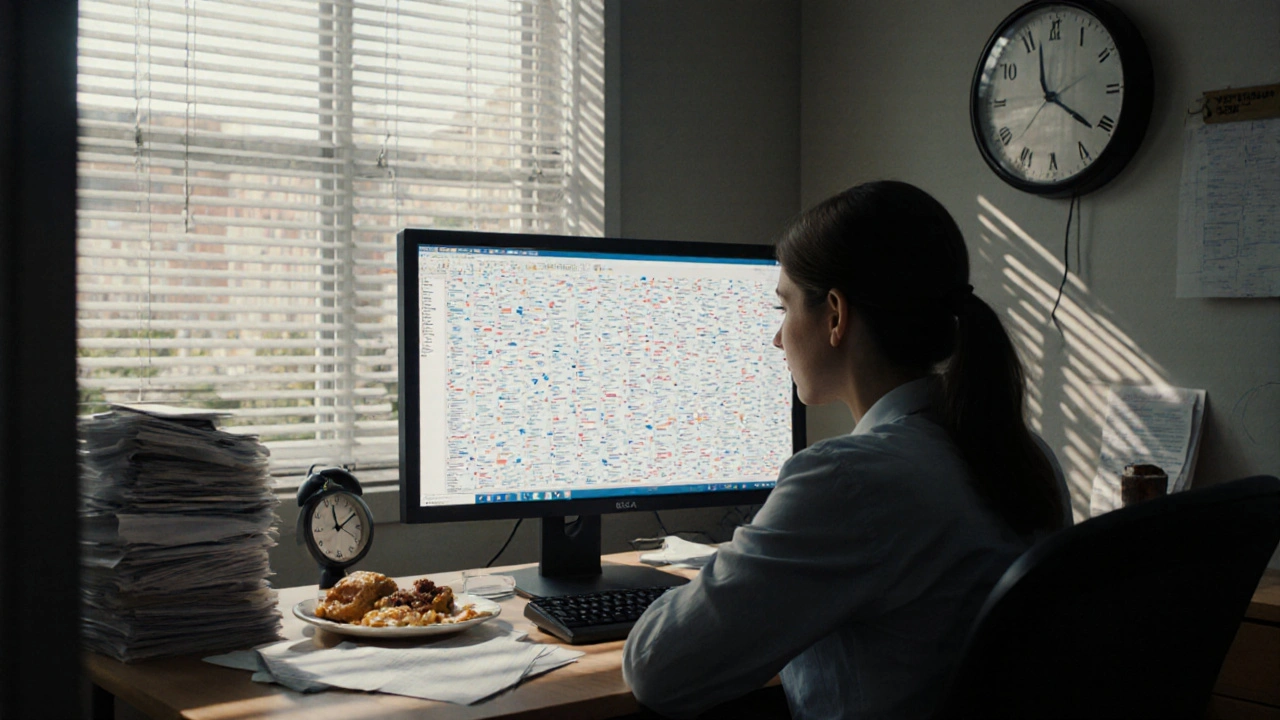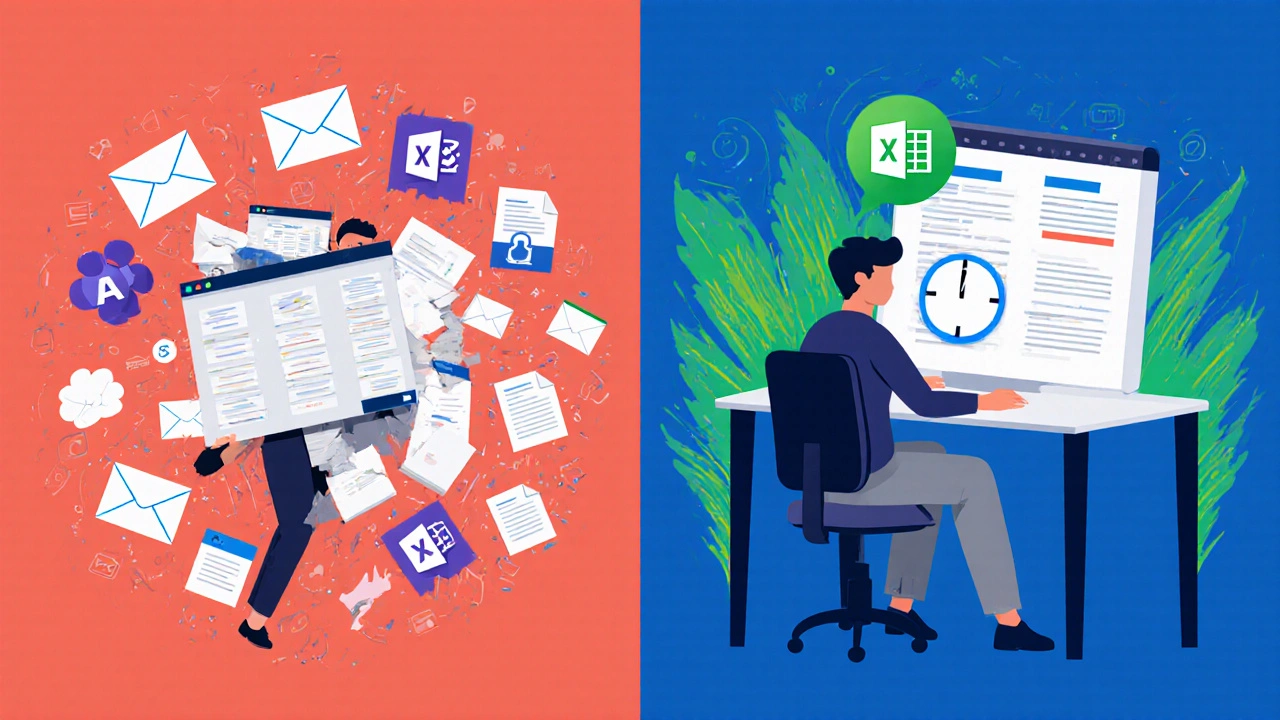
Every Monday morning, university staff in the UK open their inboxes to find 87 new emails. Not 8 or 80-87. And that’s just from students. Add in department heads, external examiners, HR requests, IT tickets, funding forms, and audit reminders, and you’re staring at over 200 messages before lunch. This isn’t unusual. It’s the new normal. And it’s breaking people.
At the University of Manchester, a 2024 internal survey found that 68% of administrative staff spend more than 4 hours a day just sorting, replying to, and filing emails. Another 19% said they routinely work through lunch, weekends, or holidays just to keep up. The result? Burnout rates have jumped 42% since 2020. This isn’t about being busy. It’s about being buried under repetitive, low-value tasks that don’t need human judgment-but still demand human attention.
Why Email Feels Like a Full-Time Job
Email isn’t the problem. Batch work is.
Batch work means doing the same kind of task over and over-replying to the same question about deadlines, approving the same form for extensions, sending the same template for transcript requests. It’s not complex. It’s not creative. It’s just endless. And because each email feels urgent, your brain treats them all like emergencies. That’s why you’re constantly switching between tasks, never finishing one, always feeling behind.
At the University of Edinburgh, one admin worker told me she spends 15 minutes answering the same question: "Can I submit my assignment late?" She gets this email 12 times a day. Each reply takes 3 minutes to type, 2 minutes to check the policy, and 1 minute to send. That’s 90 minutes a day-over 18 hours a month-just on one question. Multiply that across 15 similar queries, and you’ve got a 30-hour workweek spent on auto-pilot.
These tasks aren’t hard. They’re just infinite. And because they’re scattered across platforms-email, student portals, SharePoint, Teams-you’re constantly context-switching. Your brain doesn’t get a break. It just runs on fumes.
The Hidden Cost of Constant Interruptions
Every time you switch from replying to an email to filling out a form, your brain needs 23 minutes to fully refocus, according to research from the University of California, Irvine. That’s not a suggestion. That’s a measurable loss of mental energy.
Imagine this: You’re in the middle of processing 30 student appeals. You get an email: "My visa is expiring, can you help?" You pause, dig up the international office’s contact list, draft a reply, send it. Now you have to find your place in the appeals again. You reread the last one. You lose track of the next step. You feel frustrated. You scroll through your inbox again to check if anything else came in.
That cycle repeats 10 times a day. That’s 230 minutes of lost focus. That’s almost four hours of productivity gone-just from interruptions.
And here’s the kicker: Most of these interruptions could be automated. Or at least, grouped. But universities still rely on manual processes because "that’s how it’s always been done."
Batch Processing: The Simple Fix No One Talks About
Batch processing isn’t fancy. It’s not AI. It’s just doing similar tasks together, in one block of time.
Instead of checking email all day, you set three fixed times: 9:30 AM, 1:00 PM, and 4:00 PM. Everything else gets ignored until then. No pop-ups. No notifications. No panic.
At the University of Leeds, the finance team started batching their work. They grouped all student fee queries, all travel claim forms, and all room booking requests into daily 45-minute blocks. Within two weeks, their average reply time dropped from 14 hours to 2.5 hours. Why? Because they stopped reacting. They started processing.
Here’s how to do it:
- Identify your top 5 most common tasks. These are your batch buckets.
- Find templates for each. Use Mail Merge if you’re on Outlook. Use canned responses in Gmail.
- Block 30-60 minutes twice a day for each bucket. One morning, one afternoon.
- Turn off email notifications outside those windows.
- Use a simple spreadsheet to track how many you processed each day.
One admin at the University of Birmingham started batching her student extension requests. She used a Google Form that students fill out with their ID, course, and reason. She then runs a daily report, approves or denies in bulk, and sends one automated email to all. Her workload dropped from 60 individual replies a day to 12 bulk actions. She gained back 3 hours a day.

Why Templates Don’t Work (And How to Make Them Work)
Most universities give staff templates. But they’re useless.
Why? Because they’re too long. Too formal. Too full of jargon. Students don’t read them. Staff don’t want to send them.
Here’s what actually works:
- Short. Under 100 words.
- Clear action. "You can submit late by Friday. Here’s the link."
- Human tone. "I know deadlines are stressful. Here’s what you need to do."
- One link. No more than one. Don’t bury them in options.
At the University of Sheffield, a team rewrote their 12 most common email templates. They cut the average length from 210 words to 65. Response satisfaction scores jumped from 58% to 89%. Students said they finally understood what to do. Staff said they stopped dreading replies.
Test this: Next time you reply to the same question, write the answer like you’re texting a friend. Then make it a little more professional. That’s your template.
What You Can’t Automate (And What You Should Stop Doing)
Not everything can be batched. Some emails need care. A student in crisis. A parent worried about their child. A colleague asking for help during a tough time.
But here’s what you should stop doing:
- Replying to emails the moment they arrive.
- Keeping your inbox open all day.
- Using email for urgent requests. Use Teams or a dedicated helpdesk form instead.
- Trying to be perfect. A 90% good reply is better than a 100% perfect one you never send.
At the University of Glasgow, staff were encouraged to use a "2-minute rule": If a task takes less than two minutes, do it now. If it takes longer, schedule it. That simple rule cut their daily email volume by 31% in six weeks.

What’s Really Holding You Back?
The biggest barrier isn’t workload. It’s guilt.
You feel like you should answer every email right away. You worry people will think you’re lazy. You think if you don’t respond instantly, someone will suffer.
Here’s the truth: No one is keeping track of your reply speed. No one is judging you for batching. What they care about is whether you solve their problem. And you can do that just as well-better, even-by being focused, not frantic.
One head of admin at Cardiff University told me: "I used to answer emails at 11 PM. Now I don’t open my inbox after 6 PM. My team started doing it too. We’re not less productive. We’re just less tired."
Start Small. Win Big.
You don’t need a system overhaul. You don’t need new software. You just need to change one habit.
Try this tomorrow:
- Turn off email notifications.
- Set two 45-minute blocks: one at 10 AM, one at 3 PM.
- At 10 AM, open your inbox and process only student deadline requests.
- At 3 PM, process only form approvals.
- Ignore everything else until tomorrow.
At the end of the day, count how many emails you processed. Then count how many you didn’t answer. You’ll be surprised: the world didn’t end. And you’ve got two hours back.
That’s not magic. That’s management. And it’s the only way to survive the flood.
Why do university staff feel overwhelmed by email even though they’re not teaching?
Because administrative roles now handle hundreds of repetitive, low-priority tasks daily-extension requests, form approvals, transcript queries-that require human review but no real decision-making. These tasks are scattered across platforms and treated as urgent, creating constant context-switching. A single staff member can spend 4+ hours a day just replying to the same few questions, leaving no time for complex or meaningful work.
Can batch processing really save time for university admins?
Yes. At the University of Leeds, staff who batched student fee and travel claims reduced their average reply time from 14 hours to under 3 hours. By grouping similar tasks into focused blocks, they eliminated constant interruptions, reduced mental fatigue, and processed more in less time. One admin at Birmingham saved 3 hours a day by switching from 60 individual replies to 12 bulk actions using automated templates.
What’s the best way to create email templates that students actually read?
Keep them under 100 words, use plain language, and focus on one clear action. Avoid jargon like "per university policy." Instead, say: "You can submit late by Friday. Here’s the link." At Sheffield, rewriting templates from 210 words to 65 increased student satisfaction from 58% to 89%. The key is being human, not formal.
Should I reply to every email immediately?
No. Responding instantly trains your brain-and others-to expect constant availability. The 2-minute rule works better: if a task takes less than two minutes, do it now. If it takes longer, schedule it. At Glasgow, this simple shift cut daily email volume by 31%. Students still get answers-just not in real time. And they’re fine with that.
How do I stop feeling guilty for not replying right away?
Guilt comes from believing you’re failing. But you’re not. You’re protecting your focus. At Cardiff University, the head of admin stopped checking email after 6 PM. Her team followed. Productivity didn’t drop. Burnout did. Students still got answers. They just got them when you were ready to give them. That’s not neglect. That’s sustainability.
Start tomorrow. Block two times. Turn off notifications. Process in batches. You’ll get more done. And you’ll finally feel like you’re not drowning.